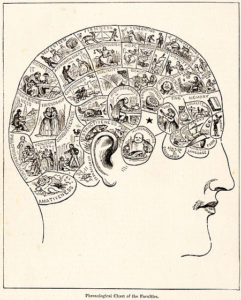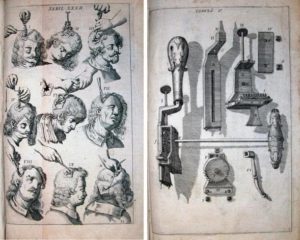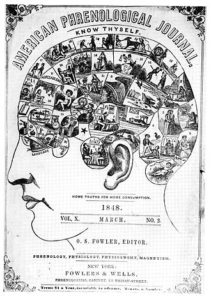
Phrenology Chart, 1883
Phrenology was a so-called “science” which believed that bumps and other physical characteristics of a person’s head (skull) could reveal personality, mental faculties, and character. Though it fell out of favor in Europe by 1840 or so, two American brothers–Lorenzo and Orson Fowler–began “reading heads” about that time and kept this field of study popular in the U.S. until the late 1800s.
In 1896, a seaman named J. S. Doherty became “dangerously and hopelessly insane” after studying spiritualism. A family friend who was also a phrenologist believed that Doherty, who had been interested in spiritualism for ten years, had studied “on this one question of spiritualism until that part of his brain was abnormally developed.”

A Trepanning Operation and Tools For It, circa 1655
By 1899 Doherty had been insane three years, and his family was clutching at straws. They suggested an operation and signed an agreement that they would not hold their phrenologist friend responsible if it was not successful.
Their friend “located the parts of the head which he argued were afflicted by the pressure of the brain against the skull.” The phrenologist then performed a trepanning operation, in which he removed (and replaced) part of the patient’s skull in order to access the brain.

American Phrenological Journal
“When Doherty recovered he was perfectly sane, and his first words were to inquire about a piece of work on which he was engaged three years ago,” wrote a reporter in the September 9, 1899 issue of The Dayton Herald.*
*Other newspapers reported on the Doherty operation as well.